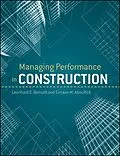Construction is the country's single largest manufacturing industry. However, it is a sector that lacks benchmarks against which to gauge performance. This modern thinking intends to provide insight to construction productivity improvement. Taking cues from manufacturing sectors such as computer, automobile and chemical companies, this book will apply the lessons learned to building construction. Supported with a range of pedagogical devices, the book will be of equal value to construction managers and civil engineers, and students with different learning methods.
Autorentext
Leonhard E. Bernold, Ph.D., Raleigh, North Carolina Associate Professor, Department of Civil Engineering, North Carolina State University. Director of the Construction Automation and Robotics Laboratory, North Carolina State University.
Simaan M. AbouRizk, PE, PhD, Edmonton, Alberta, Canada; NSERC/Alberta Construction Industry Research Professor, University of Alberta. Executive Board member, Construction Research Institute of Canada.
Inhalt
Preface xiii
Chapter 1 Indicators of an Industry in Transition 1
1.1 Breaking Interoperability Barriers 1
1.2 Construction Becomes Sustainable 2
1.3 E-Construction Management 3
1.4 Linking Up to Smart Construction Equipment 5
1.5 Highly Successful Engineering Managers 5
Chapter Review 8
Bibliography 9
Chapter 2 Productivity in the Spotlight 13
2.1 Measuring National Productivity 13
2.2 Basic Relationships Affecting Productivity 15
2.3 Factors Related to Process Productivity 17
2.3.1 Necessary Work Resources 17
2.3.2 Job Fitness 19
2.3.3 Where the Rubber Meets the Road: The Process 19
2.3.4 Value-Added and No-Value-Added Outputs 24
2.3.5 Control Mechanisms for Keeping Processes on Target 26
2.4 Taxonomy of Work Time 32
2.5 Gauging Construction Process Efficiency 37
2.5.1 Scientific Measurements of Individuals at Work 38
2.5.2 Measuring Value-Added Work 41
2.5.3 The Continuous Time Study 43
2.5.4 Work Sampling 47
2.5.5 Sensor-Based Work Measurement 51
2.6 Identifying Critical Impact Factors 53
2.6.1 Understanding the Cause of Inefficiency 53
2.6.2 Functions for Corrective Interventions 57
2.6.3 Critical Success Factors 58
2.6.4 Bipolar Success Factor Analysis 62
Summary 62
Chapter Review 66
Bibliography 70
Chapter 3 Cornerstones of Efficient Site Operation 75
3.1 Return of the Master-Builder 75
3.1.1 Separating Design from Construction Expertise 76
3.1.2 The Rise of Constructability Expertise 77
3.1.3 The Emergence of Intelligent Building Data Models 79
3.2 Planning the Supply, and Resupply, of the Construction Process 79
3.2.1 Modeling the Construction Input Supply Chain 80
3.3 Top-Down Frameworks for Managing Projects 83
3.3.1 Organizational Structures That Facilitate Integration 84
3.3.2 Sequencing the Plan, Start to Finish 86
3.4 Bottom-Up Quantitative Planning 87
3.4.1 Defining the Process Model 88
3.4.2 Computing Process Production 88
3.4.3 Optimizing the Process 97
3.5 Process Synchronization in the Supply Chain 101
3.5.1 Costly Two-Way Ripples in the Supply Chain 101
3.5.2 Just-in-Sequence Material Supply 103
Chapter Review 114
Bibliography 117
Chapter 4 Introduction to Simulation and Its Use in Modeling Production Systems 121
4.1 Building Simulation Models 127
Chapter Review 139
Chapter 5 A Case Study: Applying Simulation to Tunnel Construction 143
5.1 Project Background 143
5.2 Preparation Work: Understanding the Construction Process 145
5.2.1 Shaft Construction 146
5.2.2 Tunnel Construction 147
5.3 Developing the Simulation Model 153
5.3.1 Assumptions and Input 153
5.3.2 Simulation Model 156
5.4 Running the Model and Deriving Results 164
5.5 Analyzing the Operation 165
Chapter Review 168
Chapter 6 Competencies That Drive the Company 173
6.1 Generic Work Competencies for the Twenty-First Century 174
6.2 Managerial Competencies of Productive Organizations 175
6.2.1 Hierarchical Structure of Construction Companies 175
6.2.2 Diverse Expectations of a Precast Plant Manager 178
6.2.3 Core Competencies of a Precast Plant Manager 182
6.3 Gaining Competency through Learning and Training 187
6.3.1 The Learning Organization (LO) 188
6.3.2 Taxonomies for Learning and Training 189
6.3.3 Teaching and Learning around the Circle 194
6.3.4 The Learning Curve 196
6.3.5 The Relearning Curve 200
6.4 Job-Oriented Training and Competency Development 204
6.4.1 Personal Learning Strengths Dictate Progress 204
